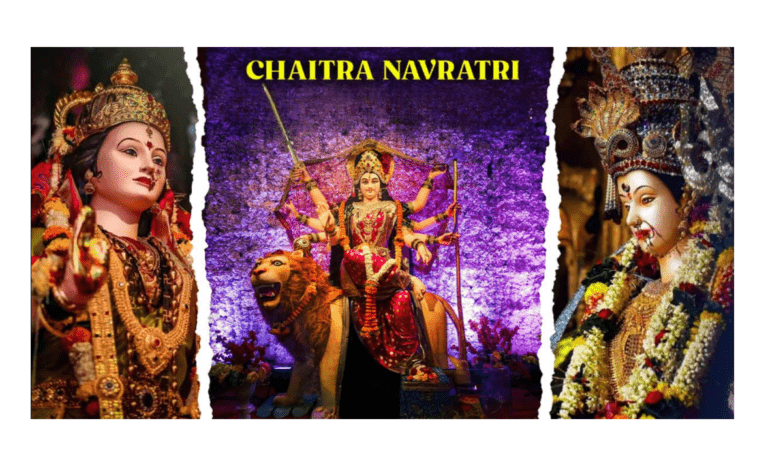
Nine nights of divine energyThe spiritual essence of Chaitra Navratri
By: Dr. Avi Verma
Chaitra Navratri, an auspicious nine-day festival dedicated to the worship of Goddess Durga, is currently being observed across India and by devotees worldwide. This sacred period, which began on March 30, will conclude on April 7, with Ram Navami being celebrated on April 6, marking the birth of Lord Rama. During these nine days, devotees immerse themselves in fasting, prayers, and spiritual reflection, invoking the divine feminine energy that governs the cosmos.
The Spiritual Significance of Chaitra Navratri
Unlike Sharad Navratri, which occurs in autumn and is widely celebrated with grand festivities, Chaitra Navratri takes place during the spring season. It is believed that during these nine days, Goddess Durga manifests in her nine divine forms, each representing different aspects of power, wisdom, and devotion. These manifestations, collectively known as Navadurga, are venerated each day with specific rituals, colors, and offerings.
Navratri also aligns with the seasonal transition, signifying renewal and transformation. Devotees undertake fasting, practice self-discipline, and engage in meditative worship to purify the mind and body. It is believed that sincere devotion during this period brings blessings, strength, and prosperity.
The Nine Forms of Goddess Durga and Their Significance
Each day of Navratri is dedicated to a specific form of Goddess Durga, embodying unique attributes that guide devotees on a spiritual path.
Day 1: Shailaputri – The Daughter of the Mountains
The first day of Navratri begins with the worship of Shailaputri, who is considered an incarnation of Goddess Parvati. She is depicted riding a bull, holding a trident in one hand and a lotus in the other. Her name means “daughter of the mountains,” symbolizing purity, patience, and stability. Worshipping her instills strength and a firm foundation in life.
Day 2: Brahmacharini – The Goddess of Penance and Devotion
On the second day, devotees honor Brahmacharini, the ascetic form of Goddess Durga, representing penance, self-discipline, and the pursuit of wisdom. She is depicted holding a rosary and a water pot, walking barefoot in deep meditation. She inspires devotees to embrace inner strength and dedication.
Day 3: Chandraghanta – The Goddess of Courage and Grace
The third day is devoted to Chandraghanta, a fierce yet benevolent form of the Goddess, known for her bravery and ability to annihilate evil forces. She carries various weapons and has a crescent moon (Chandra) adorning her forehead. Worshipping her helps devotees overcome fear and obstacles, bringing peace and divine grace.
Day 4: Kushmanda – The Creator of the Universe
On the fourth day, devotees revere Kushmanda, who is believed to be the creator of the universe. Her name translates to “the one who creates the cosmic egg (Brahmanda) with her divine smile.” She is depicted as radiating immense energy, bringing warmth, light, and vitality to the cosmos. Worshipping her bestows health, prosperity, and strength.
Day 5: Skandamata – The Nurturing Mother of Lord Kartikeya
The fifth day of Navratri is dedicated to Skandamata, the mother of Lord Kartikeya (also known as Skanda). She is portrayed holding her son in her lap while seated on a lotus. She symbolizes motherly love, protection, and divine grace. Devotees seek her blessings for wisdom, good health, and a fulfilling life.
Day 6: Katyayani – The Warrior Goddess of Strength
On the sixth day, devotees worship Katyayani, the fierce warrior form of Goddess Durga. She is believed to have been born from the collective energy of the gods to defeat the demon Mahishasura. She is often depicted holding a sword and riding a lion, symbolizing courage and righteousness. She is also considered the Goddess who grants wishes, especially to those seeking a harmonious marital life.
Day 7: Kalaratri – The Destroyer of Darkness and Evil
The seventh day is dedicated to Kalaratri, the most ferocious form of Durga. She is depicted with dark skin, wild hair, and a blazing aura, riding a donkey. She eliminates ignorance, fear, and negativity, leading her devotees toward spiritual awakening. Despite her fearsome appearance, she is deeply benevolent and grants protection to those who seek her refuge.
Day 8: Mahagauri – The Goddess of Purity and Serenity
The eighth day, known as Maha Ashtami, is dedicated to Mahagauri, who represents purity, tranquility, and wisdom. She is depicted wearing white attire, riding a bull, and radiating a peaceful glow. Her devotees seek her blessings for inner transformation, spiritual clarity, and a serene life.
Day 9: Siddhidatri – The Goddess of Divine Powers and Fulfillment
On the ninth and final day of Navratri, devotees worship Siddhidatri, the granter of siddhis (supernatural abilities) and divine knowledge. She is believed to bless her devotees with wisdom, enlightenment, and spiritual fulfillment. She completes the cycle of Navadurga, signifying the culmination of devotion and the realization of divine grace.
The Grand Conclusion: Ram Navami and Kanya Puja
As Chaitra Navratri reaches its peak, the festival concludes with the celebration of Ram Navami on the ninth day. Devotees commemorate the birth of Lord Rama, the seventh incarnation of Vishnu, who embodies righteousness and dharma. Grand processions, bhajans (devotional songs), and recitations from the Ramayana mark the day’s significance.
Additionally, Kanya Puja, a ritual dedicated to worshipping young girls as manifestations of the Goddess, is performed. Devotees invite nine girls, symbolizing the nine forms of Durga, and offer them food, gifts, and blessings as a gesture of honoring the divine feminine energy.
A Time for Devotion and Renewal
Chaitra Navratri serves as a time of spiritual rejuvenation, allowing devotees to reflect on their inner selves while seeking divine guidance. The festival not only honors the power of Goddess Durga but also reinforces values of courage, wisdom, and purity in daily life. Through fasting, prayers, and acts of devotion, worshippers invoke divine blessings, paving the way for personal and spiritual transformation.
As this sacred period continues, devotees across the world immerse themselves in its spiritual essence, celebrating the profound connection between humanity and divinity.